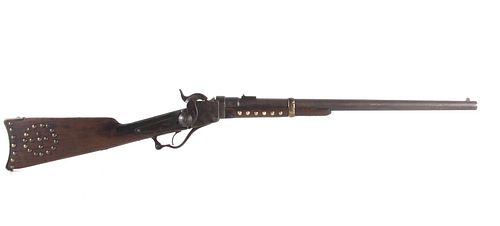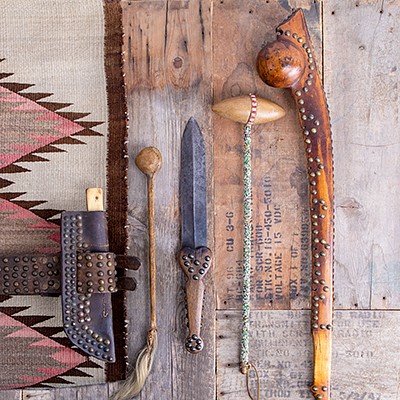Battle of the Little Bighorn Starr 1862 Carbine
Two ways to bid:
- Leave a max absentee bid and the platform will bid on your behalf up to your maximum bid during the live auction.
- Bid live during the auction and your bids will be submitted real-time to the auctioneer.
Bid Increments
| Price | Bid Increment |
|---|---|
| $0 | $5 |
| $50 | $10 |
| $100 | $25 |
| $500 | $50 |
| $1,000 | $100 |
| $2,000 | $250 |
| $5,000 | $500 |
| $10,000 | $1,000 |
| $25,000 | $2,500 |
| $100,000 | $5,000 |
About Auction
Mar 19, 2022
Explore one of the finest collections of American Indian Weapons & Beadwork along with a phenomenal assortment of Navajo Jewelry, Western History, Original Art and Luxury Jewelry. North American Auction Company tucker@naabid.com
- Lot Description
This is an outstanding and historic original Starr Percussion Breech Loading Saddle Ring Carbine Carbine from 1862 from Black Eagle Sans Arc from the Battle of the Little Bighorn. This is a United States Cavalry Civil War Issue Starr Percussion Breechloading (breech loading) carbine chambered in .54 caliber. The carbine has been examined and attributed to have been used by Chief Black Eagle Sans Arc at the Battle of the Little Bighorn in circa 1876. The rifle was examined by Wendell Grangaard from The Guns of History, Inc in Sioux Falls, South Dakota and found to be marked in Lakota Togia language. The name Black Eagle Sans Arc is found on the left wrist, as shown on illustration 1 and 2 as well as on the right side of the action, illustration 3. Black Eagle is written on the right side of the stock along with the original solid brass square shank early trade tacks buttons in the configurations of the Scarlet Clothe Earring Band of the Sans Arc and Black Eagle personal mark of seven buttons, illustration 4. There is also a brass tacked symbol which stands for the Itazipcho Band (The Without Bows Band) Black Eagle’s personal mark of seven buttons. There are also six brass tacks on each side of the forearm which are prayer symbols. Black Eagle was born in 1822 to Sans Arc Lakota Sioux parents and later he married Yellow Woman in 1860 having two daughters, Yellow Woman in 1861 and Plenty Woman in 1879. From 1865 to 1880, there were eight bands of Sans Arc led by a chief, Black Eagle was the Chief of the Sin Luta Oin otherwise known as the Scarlet Cloth Earrings Band. When war was declared, representative of the Sans Arc Blue tribe Blue Coat voted for war. Black Eagle and his band were documented as being at the Battle of the Little Bighorn, also known as the Battle of Greasy Grass and Custer’s Last Stand. White Bull, Sitting Bull’s nephew testified that Black Eagle was one of the Sans Arc Band leaders and was present at the Battle of the Little Bighorn. This rifle is thought to have accompanied him into the battle, making this a truly historic and iconic piece. Later Black Eagle and the Sans Arc Band followed Sitting Bull into Canada and later surrendered at Fort Buford on January 21, 1881, and were sent to Standing Rock Indian Reservation, then transferred to the Cheyenne River Indian Reservation settling along Cherry Creek. (Sources: The Guns of History, Inc; Kingsley Bray, “The Sans Arc, 1850-1870”; Ephraim D. Dickson III, “The Sitting Bull Surrender Census: The Lakotas at Stadning Rock Agency, 1881”; and Richard G. Hardoff, “Lakota Recollections of the Custer Fight: New Sources of Indian-Military History”. Included with the lot is the 21 page folder signed historic examination from Wendell Grangaard. The rifle is marked on the right side of the receiver in two lines, “STARR ARMS CO. YONKERS N.Y.” with a “B” proof mark above, the breech loading lever is stamped “B” on the left side, the breech loading block is marked with numbers visible “266” when the block has fallen and is open, the left side of the barrel at the barrel to receiver connection is stamped “L.A.B.”, the brass original carbine barrel band is stamped “U”, the top of the barrel is marked in a single line “STARR ARMS CO. YONKERS N.Y.”, the left side of the tip up original sight is marked “B”, the crescent brass butte stock is marked on the top “B”, the back of the grip reading "STARR'S PATENT SEPT 14th 1858". The carbine has a lever action breech loading of falling action which functions by releasing the lever lock at the back and pushing the lever down till it is vertical dropping the block which giving access to the breech and exposing the nice condition original rifling. The hammer pulls back completely but does not click or catch, the trigger moves but does not catch, the breech loading mechanism appears to function well. The right side of the lock plate has a missing screw to the right of the two line address mark and what appears to be a replacement screw to the far left on the same plate. The rifle has some slight pitting but overall displays well. The brass has a nice mellow honest coloring and the wood overall has expected wear with dark coloring, the right side of the stock has a darker colored spot which is presumably from the user placing their palm and thumb on this spot repetitively but could also be some type of alterations. The Starr Carbine was designed in 1858 by Ebenzer Starr and was issued by the United States to the cavalry soldiers for use in the American Civil War and later carried by cavalry soldiers during the Indian Wars. The Starr carbine closely resembled the more famous “Sharps” breechloading carbine which was also issued to Union cavalrymen during the Civil War. The first shipment of 1,000 Starr carbines was delivered to the Ordnance Department in September 1863 with a total of 20,000 weapons being purchased by the U.S. government. The carbine employed a split breech, dropping block mechanism that allowed the trooper to insert a linen cased cartridge into the barrel breech chamber for loading. Upward motion of the operating lever / trigger closed the breech, and ignition was activated with the striking of the percussion cap by the external side hammer. Overall the carbines measured 38 inches long. The Saddle Ring Carbine is shown on the left side. This is truly a historic and rare example showing wonderful documentation as being attributed to the Battle of the Little Bighorn. With a serial number of 266 this is thought to be on of the earlier rare 1862 manufactured examples as part of the first shipment to the government. Antique Firearm does NOT require an FFL or background check.
- Shipping Info
-
North American Auction Company is proud to announce the opening of our new in-house, full-service shipping department. We have listened to you the customer and will now be handling all outgoing packages in our new shipping department. We are confident this new offering will allow for a smooth transition from auction block to your front step. We have partnered with preferred carriers to ensure a safe, efficient delivery that works best with your schedule. Please allow 14-21 days after complete invoice payment is made to package and ship your purchase. After you are notified of your winning bids from our company and your item invoice is paid in full our new shipping department will contact you. Make sure when signing up with our company that your preferred shipping information is up to date as this information will be used to estimate shipping cost. Once the items have been packaged our team will contact you for shipping payment. Shipping invoices and payment will be completely separately than the items invoice. Please notify the shipping department with any alternate request or instructions at mark@northamericanauctioncompany.com or 800-686-4216 ext. 3. For a shipping quote please contact the same information above. PLEASE NOTE a shipping quote price can fluctuate in price. Auction company is not responsible for actual shipping cost being higher than quoted shipping cost. Thank you for trusting North American Auction Co. with your bids and shipping. As our shipping department is brand new please understand that delays can be expected.
-
- Buyer's Premium



 EUR
EUR CAD
CAD AUD
AUD GBP
GBP MXN
MXN HKD
HKD CNY
CNY MYR
MYR SEK
SEK SGD
SGD CHF
CHF THB
THB























